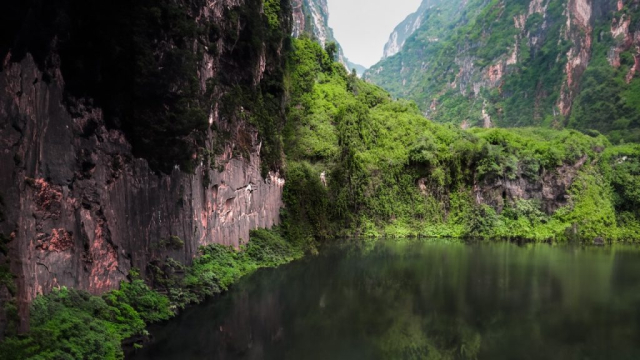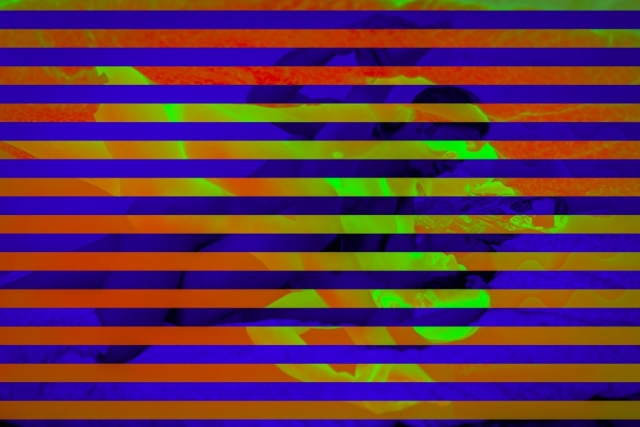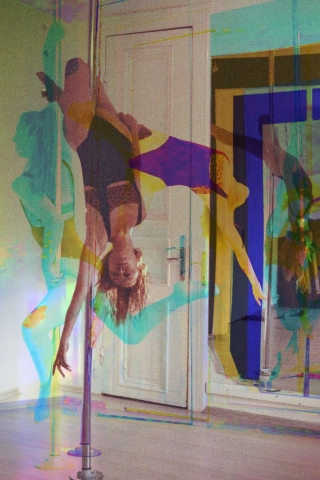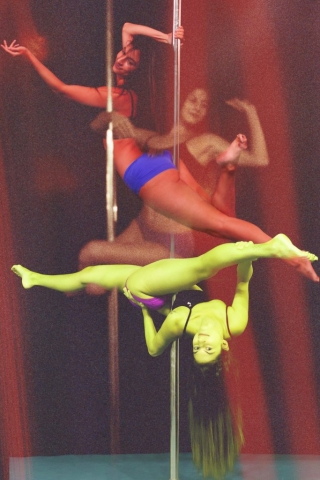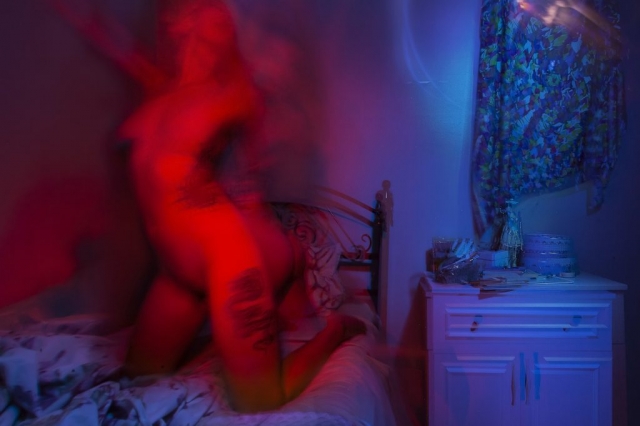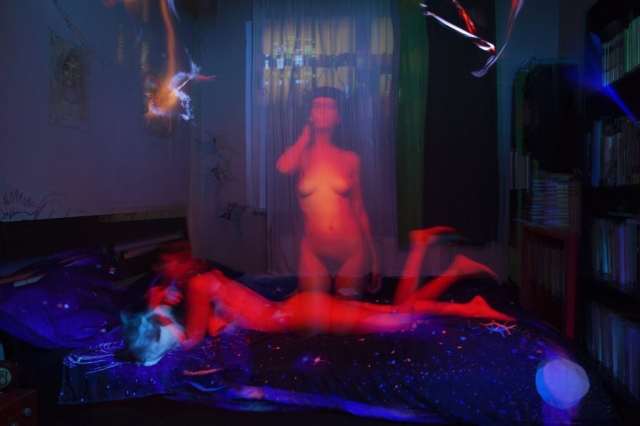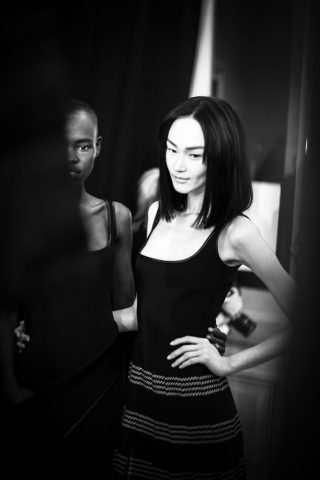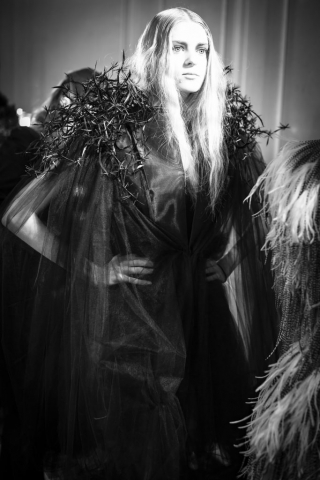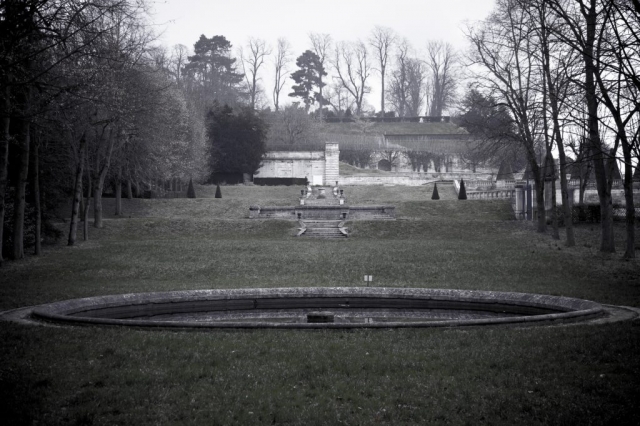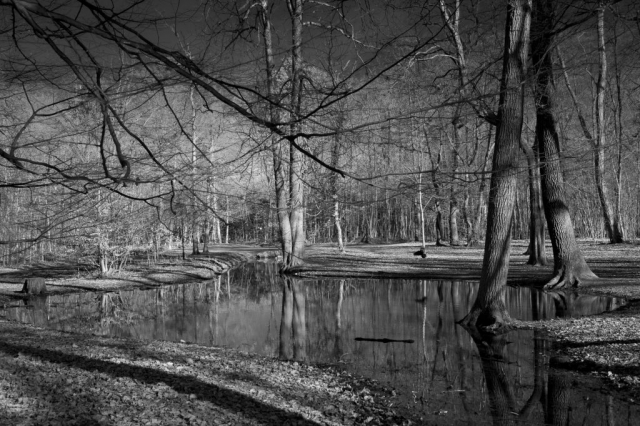A(m) I ART(ificial) - 2024
EN
“Algorithmic Aesthetics: The Future of Artistic Imagination and Artificial Intelligence”
Art has existed for centuries as a reflection of human experience, thought, and sensibility. “A(m) I ART(ificial)” offers a new perspective by incorporating the contribution and intervention of artificial intelligence into these traditional paradigms of artistic creation. Within the concept of algorithmic aesthetics, it explores how artificial intelligence can add new meanings and aesthetic dimensions to the processes of artistic creation and the work itself.
Artificial intelligence has the potential to create a new artistic language in the hybrid spaces between art and technology. The transformation of photography and video through artificial intelligence; transmedial exchanges extending from visual to text, and from text to visual narration, challenge the boundaries of artistic expression. “(Am) I ART(ificial)” questions how this transformation affects the language and structure of the visual arts and invites a deep contemplation on what art is and what it could be.
The collaboration between the artist and the algorithm points to creation processes that go beyond immediate reality. When the aesthetic decisions of artificial intelligence are combined with the intent and creativity of the human artist, unexpected and innovative artistic experiences emerge. The works, by passing the images of nature and the human form through the objective filter of the algorithm, challenge and expand the observer’s subjective perception.
“A(m) I ART(ificial)” serves as a meditation space on the future of art and artificial intelligence, questioning the anthropocentric origins of aesthetic creation. The exhibition leaves it to the viewer to determine whether works created or transformed by artificial intelligence are unique products of human creativity or represent a new evolution of art.
This space of dialogue and experience provides a platform to reassess the impacts of technology on art and the role of the artist. It invites art enthusiasts to explore the roles of technology in the production of aesthetics and meaning, to rethink the boundaries of contemporary art, and to deeply discuss what art could mean in this innovative era.
TR
"Algoritmik Estetik: Yapay Zeka ve Sanatsal İmgelemin Geleceği"
Sanat, insan deneyiminin, düşüncenin ve duyarlığın bir yansıması olarak yüzyıllardır var olmaktadır. "(Am) I ART(ificial)" sanatsal yaratımın bu geleneksel paradigmalarına yapay zekanın katkısını ve müdahalesini dahil ederek yeni bir bakış açısı sunar. Algoritmik estetik kavramı çerçevesinde, yapay zekanın sanatsal yaratım süreçlerine ve eserin kendisine nasıl yeni anlamlar ve estetik boyutlar katabileceğini keşfeder.
Yapay zekâ, sanat ve teknoloji arasındaki melez alanlarda yeni bir sanatsal dil oluşturma potansiyeline sahiptir. Fotoğrafın ve videonun yapay zekâ aracılığıyla dönüşümü; görselden metne, metinden görsel anlatıma uzanan transmedyal alışveriş, sanatsal ifadenin sınırlarını zorlar. "A(m) I ART(ificial)", bu dönüşümün, görsel sanatların dilini ve yapısını nasıl etkilediğini sorgular ve sanatın ne olduğu ve ne olabileceği üzerine derinlemesine bir muhasebeye davet eder.
Sanatçı ve algoritmanın birlikteliği, anlık gerçekliğin ötesine geçen yaratım süreçlerine işaret eder. Yapay zekanın estetik kararları, insan sanatçının niyeti ve yaratıcılığı ile birleştiğinde, beklenmedik ve yenilikçi sanatsal deneyimler ortaya çıkar. Eserler, doğanın ve insan formunun imgelerini algoritmanın objektif süzgecinden geçirerek, gözlemleyicinin öznel algısını zorlar ve genişletir.
“A(m) I ART(ificial)", sanatın ve yapay zekanın geleceği üzerine bir meditasyon alanı olarak hizmet ederken, estetik yaratımın antroposentrik kökenlerini sorgular. Sergi, yapay zeka tarafından yaratılan veya dönüştürülen eserlerin insan yaratıcılığının eşsiz ürünleri olup olmadığını, yoksa sanatın yeni bir evrimini mi temsil ettiğini izleyiciye bırakır.
Bu diyalog ve deneyim alanı, teknolojinin sanat üzerindeki etkilerini ve sanatçının rolünü yeniden değerlendirmek için bir platform sağlar. Sanatseverleri teknolojinin estetik ve anlam üretimindeki rollerini keşfetmeye, çağdaş sanatın sınırlarını yeniden düşünmeye ve bu yenilikçi dönemde sanatın ne anlama gelebileceğini derinlemesine tartışmaya davet eder.
The Trace - 2023
EN
Can Sarıçoban's 'The Trace' series offers a multifaceted exploration into the dazzling yet superficial world of fashion. Showcased at The Countless Cities Biennial in Sicily, this 9th series includes seven collages and an eye-catching sculpture, featuring various techniques applied to photographs taken during Sarıçoban's years working at Paris Fashion Week. These artworks critique the aesthetic foundations of capitalism and consumer culture, in alignment with theories by scholars like Roland Barthes and Guy Debord.
The pinnacle of this collection is the sculpture titled 'Venus with Franklin's Head.' This compelling “anti-aesthetic” piece features a brightly colored fashion mannequin carrying a headless, bloodied Venus de Milo, their bodies merged as one. At the feet of the statue lies the face of Benjamin Franklin, the emblematic figure on a hundred-dollar bill. Beyond its immediate visual impact, the sculpture interrogates the fault lines between capitalism and aesthetics, compelling viewers to reconsider their perceptions of beauty, value, and meaning.
In the collages displayed in the exhibition, minimalist paint interventions have been used, along with carefully selected objects like needles, threads, and pieces of currency. These elements serve to enrich the work's visual language and lend depth to its overarching theme, rather than merely acting as aesthetic embellishments. Positioned at the intersection of art, fashion, and philosophy, 'The Trace' series offers a complex balance between simplicity and impact. This collection invites its audience to contemplate notions of beauty, value, and meaning in a world often dominated by surface-level allure.
*
TR
Can Sarıçoban'ın 'The Trace' (İz) serisi, göz alıcı fakat yüzeysel moda dünyasına çok yönlü bir inceleme sunar. Sicilya'daki Sayısız Şehirler Bienali'nde sergilenen bu 9. seri, Sarıçoban'ın Paris Moda Haftası'nda çalıştığı yıllar boyunca çektiği fotoğraflar üzerine çeşitli teknikler uyguladığı yedi kolaj ve dikkat çekici bir heykeli içerir. Bu eserler, Roland Barthes ve Guy Debord gibi bilim insanlarının teorileriyle uyumlu bir şekilde, kapitalizmin ve tüketim kültürünün estetik temellerini eleştirmektedir.
Bu koleksiyonun zirvesi, 'Venus with Franklin's Head' (Franklin Başlı Venüs) adlı heykeldir. Bu etkileyici “anti-estetik” parça, parlak renge boyanmış bir moda mankeninin, kafası olmayan kanlı bir Venüs de Milo'yu taşımasını, vücutlarının bir oluşunu ve ayaklarının dibinde bulunan yüz dolarlık banknotun simgesi Benjamin Franklin'in kafasını içerir. Görsel etkisinin ötesinde, heykel kapitalizm ve estetik arasındaki kırık noktaları sorgular ve izleyicileri güzellik, değer ve anlam hakkındaki algılarını yeniden gözden geçirmeye zorlar.
Sergideki kolajlarda minimalst boyama müdahaleleri, iğneler, iplikler ve parça parça döviz gibi dikkatle seçilmiş objeler kullanmıştır. Bunlar, estetik süslemelerin aksine, eserin görsel dilini zenginleştirmekte ve ana temasına derinlik kazandırmaktadır. Sanat, moda ve felsefenin kesişiminde duran 'The Trace' serisi, sadelik ve etki arasında karmaşık bir denge sunar. Bu koleksiyon, izleyicisini, yüzeyel cazibenin sıklıkla egemen olduğu bir dünyada güzellik, değer ve anlam kavramları üzerinde düşünmeye davet eder.
Black Star - 2021
EN
“From the apriori naturalness to artificial humanity, mankind, trying to isolate itself from nature while covering the distance, began to experience problems from the moment it wrongly blended the human with the wild. As a result of the majority taking on a structure that displays the negative attributes of both sides, a self-destructive, ambitious, and greedy selfishness emerged. Advancing technology, united with the capitalist order, turned into a massive monster, starting to devour all the resources of the world. The risk society no longer needed great wars or epidemic diseases to perish. The rapidly growing and impoverishing population, along with the population's increasing demands, led to the need for cheaper production, and, together with the post-truth narratives that suit populist politicians and large corporations, nature began to be devastated more swiftly than ever before. However, this uncontrolled destruction of the natural structure would also bring the human structure face to face with the danger of extinction.”
Can Sarıçoban, in his 8th solo exhibition "Black Star," brings together photographs taken consecutively with three main color filters; through works that are clear within themselves but become blurry when overlapped, he explores the problematic and essential relationship between nature and humanity that can either coexist or perish together.
*
TR
“Apriori olan doğallıktan, yapay olan beşeriliğe doğru yol kat ederken kendisini doğadan ayırarak izole etmeye çalışan insanlık; insani olanı vahşi olanla yanlış bir şekilde harmanladığı andan itibaren sorunlar baş göstermeye başladı. Çoğunluğun, her iki tarafın da olumsuz özelliklerini gösteren bir yapıya bürünmesi sonucu, kendi kendisini yok eden, hırslı ve açgözlü bir bencillik ortaya çıktı. Gelişen teknoloji, kapitalist düzen ile bir olup büyük bir canavara dönüşerek, dünyanın tüm kaynaklarını yutmaya başladı. Risk toplumunun, yok olmak için artık büyük savaşlara ya da salgın hastalıklara ihtiyacı yoktu. Hızla artan ve fakirleşen nüfus ile nüfusun artan arz-talepleri daha ucuz üretim ihtiyacı doğururken, popülist politikacıların, büyük şirketlerin işine gelen post-truth anlatılarıyla birlikte doğa yeniden hiç olmadığı kadar hızlı bir şekilde harap edilmeye başlandı. Oysaki doğal yapının bu kontrolsüz yok edilişi beşeri yapıyı da yok olma tehlikesiyle karşı karşıya getirecekti.”
Can Sarıçoban, 8. Solo sergisi Black Star’da, üç ana renk filtre ile art arda çektiği fotoğrafları bir araya getirerek; kendi içlerinde net olan, ancak üst üste bindiklerinde flu bir yapıyı ortaya çıkaran eserleriyle, birlikte var olabilen ya da birlikte yok olacak olan doğa ve insanın sorunlu ve zaruri ilişkisini inceliyor.
New Wave - 2020
EN
"Since the 19th-century symbols of adulthood, seriousness, and rationalism gave way to eternal childhood, and our nomadic, tribal, and hedonistic instincts began to revive, much has changed. As we approach the end of this postmodernist transition, where everyone chooses their truths, and therefore truth becomes trivialized, the meaning crisis, mental health crisis, and relationship crisis that emerged with a pandemic that deeply shook all humanity and elevated social isolation have further strengthened this evolution.
Polarizations creating an inward, isolated structure of similar acceptances and further increasing distances with 'the other' (tribalism), the state of feeling that belongs to all the mainland while ignoring political boundaries - or the inability to feel belonging anywhere (nomadism), and the elevation of the moment over a meaningless future due to increased death awareness (hedonism), have hastened the evolution of the changing new minds.
With the trivialization of truth, the meaninglessness of the sacred, and the complete disappearance of privacy, censorship imposed from above has been attempted. In this process, where these censors will also become insignificant and vanish, and everything and everyone will become more naked, what the society that closes the modernism parenthesis completely and opens a new one will turn into, how it will resolve its conflicts and existential problems, and therefore what its new normal will be, will fully emerge when the phenomenon in this new parenthesis reaches its peak."
Can Sarıçoban, in his 7th solo exhibition "New Wave," uses postmodern images to process intimate life frames while asking various questions about the new normal and censorship. He performs a kind of deconstruction using a technique that brings together the reverse-mirror images and different color channels of each photograph. Thanks to this deconstruction occurring in the photographs, a confusing and controversial type of censorship system, where the image hides itself, is revealed.
*
TR
“19. yüzyılın sembolleri olan yetişkinlik, ciddiyet ve rasyonalizm yerini sonsuz çocukluğa bırakıp; göçebe, kabileci ve hazcı içgüdülerimiz canlanmaya başladığından beri çok şey değişti. Herkesin kendi doğrularını seçtiği, bu yüzden hakikatin önemsizleştiği bu postmodernist geçişin sonlarına yaklaşırken tüm insanlığı derinden sarsan ve sosyal izolasyonu yücelten bir pandemiyle birlikte ortaya çıkan anlam krizi, akıl sağlığı krizi ve ilişki krizi bu evrimi daha da güçlendirdi.
Kutuplaştırmalar sonucu benzer kabullerin içe kapalı, izole bir yapı oluşturarak ‘öteki’ ile mesafeleri iyice arttırması (kabilecilik), siyasi sınırları yok sayan tüm ana karaya ait hissetme hali -ya da hiçbir yere ait hissedememe hali- (göçebelik) ve ölüm bilincinin artmasıyla anlamsızlaşan gelecekten çok anın yücelmesi (hazcılık), değişmekte olan yeni zihinlerin evrimini çabuklaştırdı.
Hakikatin önemsizleşmesiyle kutsalların da anlamsızlaşması ve mahremin tamamen ortadan kalkıyor oluşu, bunların yerine yukarıdan dayatılan sansürlerin denenmesine yol açtı. Bu sansürlerin de önemsizleşerek ortadan kalkacağı; herkesin ve her şeyin daha da çıplaklaşacağı bu süreçte, modernizm parantezini tamamen kapatıp yeni bir parantez açan toplumun, çatışmalarını ve varoluşsal sorunlarını nasıl çözüp, neye dönüşeceği, dolayısıyla yeni normalinin ne olacağı, bu yeni parantezdeki olgunun pik noktasına gelmesiyle birlikte tam anlamıyla ortaya çıkmış olacak.”
Can Sarıçoban 7. kişisel sergisi New Wave’de postmodern imgeler kullanarak mahrem hayat karelerini işlerken, yeni normal ve sansür üzerine de çeşitli sorular soruyor. Her bir fotoğrafın ters-ayna görüntülerini ve farklı renk kanallarını bir araya getirdiği bir teknik kullanarak bir tür yapı bozumu gerçekleştiriyor. Fotoğraflarda oluşan bu yapı bozumu sayesinde, görüntünün kendi kendisini sakladığı, kafa karıştırıcı ve tartışmalı bir tür sansür sistemi açığa çıkıyor.
Let's Dance - 2019
EN
"A person new to the world first perceives that the universe is three-dimensional and sets out to explore it. In the three-dimensional universe, they believe that everything they discover will always more or less remain in its place, continuing as it is, as it should be. However, after a while, they will begin to notice that slight changes are occurring in their universe. As a result of these subtle changes, differences have occurred in some details of the universe they thought was three-dimensional. Thus, meeting the fourth dimension, time, the person realizes that these changes in details have accumulated, creating ever greater transformations. As they travel through the fourth dimension, they watch with amazement the results of this unstoppable motion in themselves and their surroundings. This fourth dimension, made up of these changes, resembles towering, sublime chasms formed by tiny differences accumulating. Over time, the abyss between the past and the present begins to become dizzying. Even the existence of the present becomes questionable due to the stubborn fluidity of time, and as Heraclitus said, it is proven in the mind that everything is a matter of change..."
Can Sarıçoban, in his 6th solo exhibition "Let's Dance," alludes to our relationship with the fourth dimension by using the motion in pole dancing, the continuation of changing choreographies, and the hypnotic and dizzying effect it creates through postmodern elements. In his works, created by superimposing three different frames from different moments of dance, he makes use of both a historical past film analog camera and a digital camera for different layers in each piece. The resulting multifaceted structures support the process of uncertainty and chaos created by these antiforms while showing the coincidental deformation process created by time, thereby reflecting a kind of deconstruction."
*
TR
“Dünya’ya yeni gelmiş bir insan ilk olarak evrenin üç boyutlu olduğunu algılar ve onu keşfe çıkar. Üç boyutlu evrende keşfettiği her yeni şeyin, her zaman aşağı yukarı yerli yerinde duracağını, olduğu gibi, olması gerektiği gibi devam edeceğini zanneder. Ancak bir süre sonra evreninde ufak değişimlerin meydana geldiğini fark etmeye başlayacaktır. Bu belli belirsiz değişimler sonucu üç boyutlu olduğunu düşündüğü evrenindeki kimi ayrıntılarda farklılaşmalar meydana gelmiştir. Bu şekilde dördüncü boyutla yani zamanla tanışan insan; bu ayrıntılardaki değişimlerin üst üste binerek git gide daha büyük değişimler meydana getirmiş olduğunu fark eder. Dördüncü boyutta yol aldıkça, durdurulması mümkün olmayan bu devinimin kendisinde ve çevresinde yol açtığı sonuçları şaşkınlıkla izler. İşte bu değişimlerden oluşan dördüncü boyut, minik farkların üst üste binmesiyle oluşan yüksek, yüce uçurumları andırır. Zaman geçtikçe, geçmiş ile şimdiki zaman arasındaki bu uçurum artık baş döndürücü olmaya başlar. Hatta zamanın inatçı akışkanlığı sonucu şimdiki zamanın varlığı da sorgulanır hale gelir ve Herakleitos’un dediği gibi her şeyin bir değişimden ibaret olduğu zihinde kanıtlanır...”
Can Sarıçoban; 6. solo sergisi “Let’s Dance”te direk dansındaki devinimi, koreografilerin değişerek devam edişini, yarattığı hipnotik ve baş döndürücü etkiyi postmodern öğeler vasıtasıyla kullanarak dördüncü boyut ile aramızdaki ilişkiye atıfta bulunuyor. Dansın farklı anlarından oluşan üç farklı kareyi üst üste bindirerek oluşturduğu çalışmalarında, her bir eserdeki farklı katmanlar için hem tarihi geçmiş filmli analog fotoğraf makinesi hem de dijital fotoğraf makinesinden yararlanıyor. Ortaya çıkan çok biçimli yapılar, zamanın yarattığı rastlantısal deformasyon sürecini dolayısıyla bir tür yapıbozumu gösterirken aynı zamanda bu antiformların yarattığı karmaşa belirsizlik sürecini destekliyor.
Deranged - 2018
EN
"Modernism, post-modern society, postmodern society, information society, risk society... We may actually be in a period where all these intertwine, and the boundaries between them cannot be fully determined. Everyone is living their era or eras in their own field. The field shapes general behavior patterns of that field, namely the habitus, and the habitus shapes the field. Ontologically, these concepts largely nourish one another. According to Bordieu, the objective existence conditions that each individual internalizes in their body throughout their socialization process form the permanent and transferable habitus for that individual. In this new era, where social periods intertwine, it is observed that there are no distinct boundaries for the concepts of field and habitus anymore, and every individual can have different fields and can form different habitus for each field. So how do these different personalities in different fields affect an individual's existence? How possible is it to be an individual with solid foundations at the core of their way of life and who has realized themselves? Under these conditions, the easiest way out for the individual who, in reality, has not realized themselves will be to fall into the illusion that they have 'realized and affirmed themselves.' Social media is one of the areas where this illusion can be most easily achieved today. The correspondence in relationships and sexuality of this desire for temporary approval and instant gratification in the new society has also emerged. Sexuality may have become an escape condition that is now more easily accessible but cannot bring the reality of being complete to the person... Is individuals' ability to access everything more easily every day and to experience every possibility an increase in disorder, normalizing under the principles of entropy, or is the individual concept ontologically facing the threat of extinction as a result of this irreversible dispersion?"
Can Sarıçoban's 5th solo exhibition, titled 'Deranged,' means chaos, confusion, imbalance, instability, disorder, and even madness (mentally deranged). In this work, contrary to his usual works, the artist uses long exposure-light painting technique for the first time, obtaining bright, neon-colored, moving, stimulating, and sharpness-free images, describing it as 'A kind of reaction that breaks the silence of tranquility and melancholy; even a kind of madness.
*
TR
Modernizm, modernizm sonrası toplum, postmodern toplum, bilgi toplumu, risk toplumu... Aslında hepsinin iç içe geçtiği ve aralardaki sınırların tam olarak belirlenemediği bir dönemde olabiliriz. Herkes kendi dönemini ya da dönemlerini kendi alanında yaşamaktadır. Alan; bu alana ait genel davranış şekillerini yani habitus’u, habitus ise alanı şekillendirir. Ontolojik olarak bu kavramlar büyük ölçüde birbirini besler. Bordieu’nun deyişiyle her bireyin kendi toplumsallaşma süreci boyunca kendi bedeninde içselleştirdiği nesnel varoluş koşulları, o birey için kalıcı ve aktarılabilir habitus'u oluşturur. Toplumsal dönemlerin iç içe geçtiği bu yeni dönemde alan ve habitus kavramlarının da belirgin sınırları kalmamış her bireyin farklı alanlarının olabildiği ve her alana dair farklı habituslar oluşturabildiği gözlemlenmektedir. Peki bu farklı alanlardaki farklı kişilikleri bireyin varoluşunu nasıl etkiler? Yaşayış biçiminin temelinde sağlam dayanakları olan ve kendini gerçekleştirmiş bir birey olmak ne kadar mümkündür? Bu şartlar altında; aslında kendini gerçekleştiremeyen bireyin, ‘kendini gerçekleştirdiği ve onaylandığı’ illüzyonuna kapılması onun için en kolay çıkış noktası olacaktır.
Günümüzde sosyal mecralar bu illüzyonun en kolay sağlanabildiği alanlardan biridir. Yeni toplumun bu geçici onaylanma ve anlık tatmin arzusunun, ilişkilerdeki ve cinsellikteki karşılığı da ortaya çıkmıştır. Cinsellik de artık daha kolay erişilebilen fakat kişiye tamamlanmış olma gerçekliğini getiremeyen bir kaçış durumuna gelmiş olabilir... Bireylerin; her şeye, her geçen gün daha kolay ulaşabilmesi ve her ihtimali deneyimleyebilmesi, düzensizliği artırarak entropi ilkeleri ışığında bir normalleşme midir, yoksa bu geri dönülmez dağınıklığın sonucu birey kavramı ontolojik açıdan yok olma tehditiyle mi karşı karşıyadır?
Can Sarıçoban’ın 5. solo sergisi olan ‘Deranged’ kelime anlamı olarak karmaşayı, karışmışlığı, dengesizliği, stabil olmamayı, bozukluğu ve hatta deliliği (mentally deranged) ifade eder. Sanatçı bu çalışmasında, alışılmış işlerinin tam aksine ilk kez uzun pozlama-ışık ile boyama tekniğini kullanarak, parlak, neon renkli, hareketli, uyarıcı ve keskinlikten uzak imgeler elde ederken bunu “Sakinliğin ve melankolinin sessizliğini bozan bir tür tepki; hatta bir tür cinnet hali” olarak dile getiriyor.
Bardaki Yabancı - 2017
EN
"With modernism, the foundations of a society consisting of isolated and pacified people have been laid, due to increased industrialization and urbanization. Alienation and loneliness in society, peaking with post-modernism, have risen in parallel with the 'industrial culture' created to keep the masses stable together. With the advancing technology, the addition of 'social media' as a new -auxiliary- field to the industrial culture simulation has further blurred the difference between the virtual and the real. Perhaps the situation has gone beyond Adorno's warnings.
Living the moment has become less important than “living as if” and showing it “as if.” How much power can this simulation have to penetrate deeply into the individuals in society? How possible has it been to cope with the sense of meaninglessness and the mind's relentless reality instinct? With his series titled 'The Stranger in the Bar,' Can Sarıçoban has both asked these questions by interpreting them from his perspective and wanted to review the perception of reality."
*
TR
Modernizm ile birlikte artan endüstrileşme ve kentleşme sonucunda yalıtılmış ve pasifleşmiş insanlardan oluşan bir toplumun temelleri atılmıştır. Post-modernizm ile zirveye çıkan toplumdaki yabancılaşma ve yalnızlaşma, kitleleri stabil olarak bir arada tutmak amacıyla yaratılan ‘endüstriyel kültür’ ile paralel olarak yükselmiştir. Gelişen teknolojiyle birlikte, endüstriyel kültür simülasyonuna yeni -yardımcı- bir alan olarak ‘sosyal medya’nın da eklenmesiyle sanal ile gerçek arasındaki fark iyice bulanıklaşmıştır. Belki de durum Adorno’nun uyarılarının da ötesine geçmiştir.
Anı yaşamaktan çok “-mış gibi yaşamak” ve bunu “-mış gibi göstermek” daha önemli hale gelmiştir. Peki bu simülasyon toplumdaki bireylerin ne kadar derinlerine işleyebilme gücüne sahip olabilir? Anlamsızlaşma hissi ve zihnin hiç peşini bırakmayan gerçeklik içgüdüsü ile baş edebilmek ne kadar mümkün olmuştur? ‘Bardaki Yabancı’ isimli serisiyle Can Sarıçoban hem bu soruları kendi perspektifinde yorumlayarak sormuş hem de gerçeklik algısını yeniden gözden geçirmek istemiştir.
Le Backstage - 2016
EN
For about 3 years, the artist, professionally engaged in photography during Paris Fashion Week, offers an unconventional perspective with the shots obtained from various backstages. In this work, on the one hand, he gives us a hint from the edges of all this splendor, while on the other hand, he occasionally prefers to stand in a questioning position of the reality of the roles played and even the phenomenon of fashion with his frames that sometimes drift into abstraction. The awkward stance of the franglais word 'Le Backstage,' from which the exhibition takes its name, also supports this.
Can Sarıçoban, who has been interested in the art of photography for about 10 years, says the following about his works;
“A piece is as real as the emotions it creates in the observer when it connects with the observer. A photographer must search for the emotion he wants to convey in his work through the viewfinder and must wait until he sees it. This process, which can take seconds, minutes, or sometimes much longer, is akin to a hot-cold game. However, if the shutter can be pressed at the right moment, then a kind of magic comes into play, and a 'real' piece emerges. Burkard Waldis's words come to mind here: 'To reach the secret of truth in art is to surrender one's essence, the divine essence.' I know that I am still new and at the beginning of this path, but I have taken a few small steps at least; this may be a lifelong journey of self-discovery and understanding.”
*
TR
Yaklaşık 3 sene boyunca profesyonel olarak fotoğrafçılık yaptığı Paris moda haftasının farklı sahne arkalarından elde ettiği karelerle alışılmışın dışında bir bakış açısı sunan sanatçı bu çalışmasında bir yandan tüm bu şatafatın kenarından köşesinden bize ipucusunu verirken diğer yandan zaman zaman soyuta kaçan kareleriyle, oynanan rollerin ve hatta moda olgusunun gerçekliğini sorgular pozisyonda durmayı tercih ediyor. Serginin adını aldığı franglais bir sözcük olan ‘Le Backstage’ kelimesinin eğreti duruşu da bunu destekler nitelikte.
Fotoğraf sanatıyla yaklaşık 10 senedir ilgilendiğini dile getiren Can Sarıçoban çalışmaları üzerine şunları söylüyor;
“Bir eser, gözlemci ile ilişki kurduğunda gözlemcide oluşturduğu duygular ne kadar güçlü ise o eser o kadar gerçektir. Bir fotoğraf sanatçısı da eserinde vermek istediği duyguyu vizörden aramalı, görebilene dek beklemelidir. Bazen saniyeler, bazen dakikalar, bazen çok daha uzun zaman alabilen bu süreç bir tür sıcak-soğuk oyununa benzer. Ancak doğru anda denklanşöre basılabilmişse işte o zaman bir tür büyü devreye girer ve ‘gerçek’ bir eser ortaya çıkar. Burkard Waldis’in şu sözü gelir burada akla: Sanattaki gerçeğin sırrına ulaşmak, öz varlığı, ilahi varlığa bırakmaktır.” Henüz bu yolda yeni ve başlarda olduğumu biliyorum ama en azından birkaç ufak da olsa adım attım, bu belki de hayat boyu sürecek bir kendini ve tanıma serüveni olacak.”
Au Bord De La Karadeniz - 2014
EN
'At the Edge of the Black Sea' is Can Sarıçoban's second solo exhibition, featuring landscapes of the Black Sea along the northeast coast of Turkey. The plateaus and mountains of the Black Sea region provide a different and interesting universe for landscape photography. It's a cosmos isolated enough to truly feel human solitude and question life. A distant, humid cosmos where clouds are low, and fog at times limits visibility to just a few meters.
‘Karadeniz’ is a compound word made up of Kara (Black) and Deniz (Sea) in Turkish, which not only defines the Black Sea but also the north-central and northeast region of Turkey. The Black Sea region is one of the seven regions of Turkey and encompasses almost all the provinces bordering the Black Sea. It's an area with numerous mountains and plateaus where people are well adapted to the natural conditions. The Black Sea coast receives the largest amount of rainfall and is the only region in Turkey that receives rain all year round.
*
FR
“Au bord de Karadeniz” est la deuxième exposition personnelle de Can Sarıçoban qui contient les paysages de la Mer Noire au bord du nord-est Turquie. Les plateau et les montagnes de la région mer noire nous fournit une univers différente et intéressante pour la photographie de paysages. C'est un cosmos assez isolé pour sentir bien la solitude du humain et interroger la vie. Un cosmos loin, humides où les nouages sont de sous et par fois le brouillard limite la visibilité jusqu'à quelque mètre.
‘Karadeniz’ est un mot composé de Kara (Noire) et Deniz (Mer) en turc qui ne définit pas seulement la mer noire mais aussi la région centre-nord et nord-est de la Turquie. La région de la mer Noire est une des sept régions de Turquie et regroupe la presque totalité des provinces jouxtant la mer Noire. C’est une région avec plusieurs montagnes et plateaux où des gens sont adaptés bien aux conditions de la nature. La côte de la mer Noire reçoit la plus grande quantité de précipitations et est la seule région de la Turquie qui reçoit des pluies toute l’année.
*
Le Paysage De La Solitude - 2013
EN
'Le Paysage de la Solitude' was first exhibited in 2013 in Paris at Galerie B&B and is Can Sarıçoban's first solo exhibition.
In these series, belonging to the early period of Can Sarıçoban's photographic works and set in parks in Paris and surrounding suburbs, it is possible to find traces related to the artist's years in Paris.
“The city sometimes appears to my eyes as a magical art gallery where every single point awaits to be discovered, while at other times a cold feeling of loneliness and alienation won't leave me, and a very strong desire to disappear arises within me. It's at times like these that I would find myself in endless parks, seeking an escape from the chaos of the city.”
*
FR
'Le Paysage de la Solitude' a été exposé pour la première fois en 2013 à Paris à la Galerie B&B et constitue la première exposition solo de Can Sarıçoban.
Dans ces séries, appartenant à la période initiale des travaux photographiques de Can Sarıçoban et situées dans les parcs de Paris et des banlieues environnantes, il est possible de trouver des traces liées aux années de l'artiste à Paris.
“La ville apparaît parfois à mes yeux comme une galerie d'art magique où chaque point attend d'être découvert, tandis qu'à d'autres moments, un sentiment froid de solitude et d'aliénation ne me quitte pas, et un désir très fort de disparaître surgit en moi. C'est dans des moments comme ceux-là que je me retrouvais dans des parcs sans fin, cherchant une échappatoire au chaos de la ville.”
*
TR
'Le Paysage de la Solitude', ilk olarak 2013 yılında Paris'te, Galerie B&B'de sergilenmiş olup Can Sarıçoban'ın ilk solo sergisidir.
Can Sarıçoban'ın fotoğraf çalışmalarının ilk dönemine ait, Paris ve çevre banliyölerdeki parklarda geçen bu serilerde sanatçının Paris yıllarına dair izlere ulaşmak mümkün.
“Şehir, kimi zaman gözüme her bir noktası keşfedilmeyi bekleyen büyülü bir sanat galerisi gibi görünür, kimi zamansa soğuk bir yalnızlık ve yabancılaşma hissi peşimi bırakmaz ve içimde çok kuvvetli bir gözden kaybolma isteği uyanırdı. İşte böyle zamanlarda kendimi ucu bucağı olmayan parklarda bulur, şehrin kaosundan bir kaçış arardım.”

